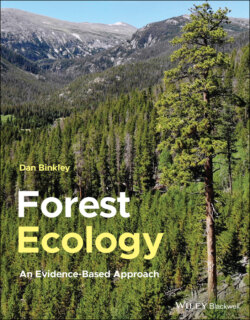Читать книгу Forest Ecology - Dan Binkley - Страница 37
Forests Receive Shortwave Sunlight, and Shine off Longwave Radiation
ОглавлениеThe sun is so hot that the wavelengths of light emitted are strong enough to activate the light sensors in our eyes. Cooler objects, like surfaces in forests, are so cool that the radiation they shine is too low in energy to activate our eyes. These radiation patterns are illustrated in Figure 2.10 for a clearcut forest in Oregon, where the incoming solar radiation hits the soil surface. Most of the shortwave solar radiation is absorbed in the system, though 13% reflects away (which is handy for us, or our eyes could not see to walk across the site). The site also receives some longwave radiation, mostly from the warm air. The soil surface shines longwave energy back the sky, and in fact the soil is hotter than the air at midday and the longwave emissions remove more energy than the sky returns as longwave emissions. When the incoming shortwave radiation from the sun stops in the evening, and the emission of radiation from the soil leads to cooling.
FIGURE 2.10 The energy budget for a forest clearcut in Oregon, USA on a summer day is driven by incoming solar (shortwave) radiation. About 13% of the light is reflected, with no effect on the forest. The rest of the solar energy is either absorbed by the forest (warming it), or evaporating water. The forest itself “shines” at long wavelengths, and the intensity of the emission depends on the daily trends in temperature. The warm air also emits longwave radiation to the forest, about 300 W m−2 through the day and night. The emission of longwave radiation from the forest increased by about 50% through the day, as absorption of shortwave solar radiation increased the thermal energy stored in the forest. The balance between incoming and outgoing fluxes of shortwave and longwave radiation determines how much energy is available to evaporate water or change the thermal energy storage (and temperature;
Source: data from Mike Newton and Liz Cole).
Combining both shortwave and longwave budgets results in a large net gain of energy (14 MJ m−2) to the soil across 24 hours. What does a net gain of 14 MJ m−2 mean for the site? It's possible that the energy moves deeper into the soil, contributing to the gradual warming of the soil over the summer. Some of the energy also leaves the site in the form of heated air that moves away. If the soil is moist, a large amount of energy could go into evaporating water (a latent heat loss): 14 MJ m−2 could evaporate about 5 l of water, or 0.5 cm of water across 1 m2.
FIGURE 2.11 The temperature of the air in the forest in northern Arizona, USA, remained above −15 °C on a winter's night, compared with −30 °C in the meadow. Some of the difference could result from cold‐air drainage from upslope, and better mixing of the air column by tree crowns, but the largest portion resulted from the high emissivity of the ground exceeding that of the air, with a greater energy loss from the soil chilling the air at the ground surface.
Source: Based on Kittredge 1948, with data from the US Forest Service.
At this point, a technical detail about temperature and emission of radiation (and loss of energy) needs to be mentioned. From the description above, it sounds like there would be no net loss of energy by longwave radiation from a soil that had the same temperature as the air. The losses of energy from the soil to the air would match the energy emitted from the air to the soil. This would be true if the soil and air were perfect “black body” emitters of radiation. Most objects are more like “gray” bodies, emitting less energy than this ideal maximum. Soils and plants are almost‐black box emitters of radiation, emitting about 90% or more of the black‐body maximum. Air is a poorer emitter, especially if humidity is high, emitting only about 70% of the maximum. This means that a soil at 8 °C will emit more energy to the air than the air at 8 °C will emit back to soil, leading to greater cooling of the soil. This difference in emissivity can lead to quite large differences in temperatures at the soil surface compared to the air a few meters above the ground. The presence of trees can increase turbulence, preventing a layer of very cool air from establishing at the ground surface. In the absence of trees, the difference in emissivity between air and ground can chill a layer of air on windless nights by 10 °C relative to a few m above the ground (Figure 2.11; Holtslag and de Bruin 1988), with dire consequences for seedlings. The presence of clouds or high humidity can prevent this severe cooling. The emissivity of water is very high, so the emission of energy from moist air toward the ground would be about the same as the ground's emission, when air and ground start at the same temperature.
